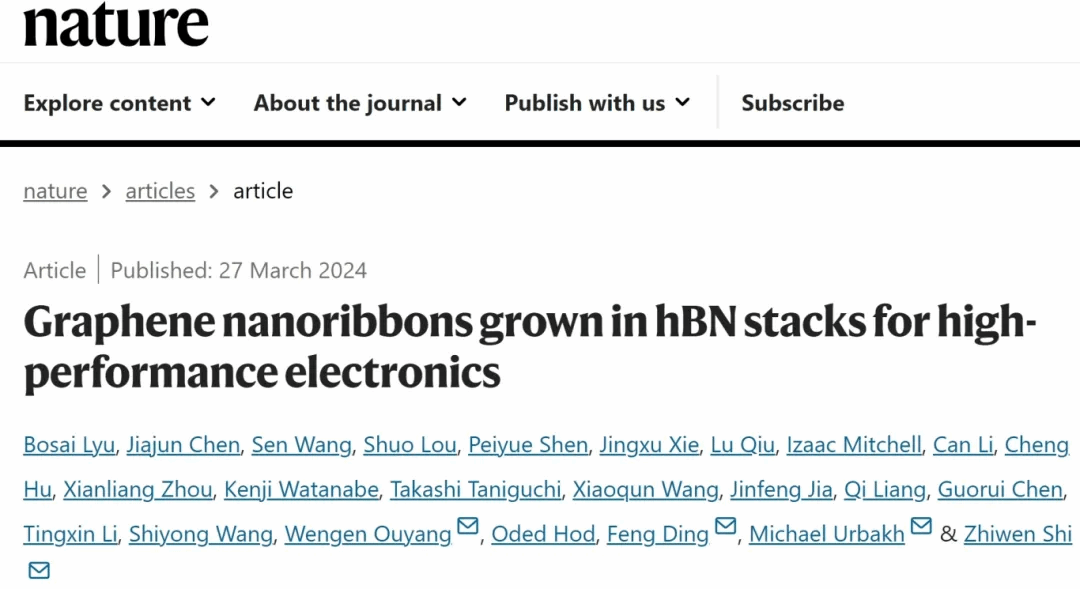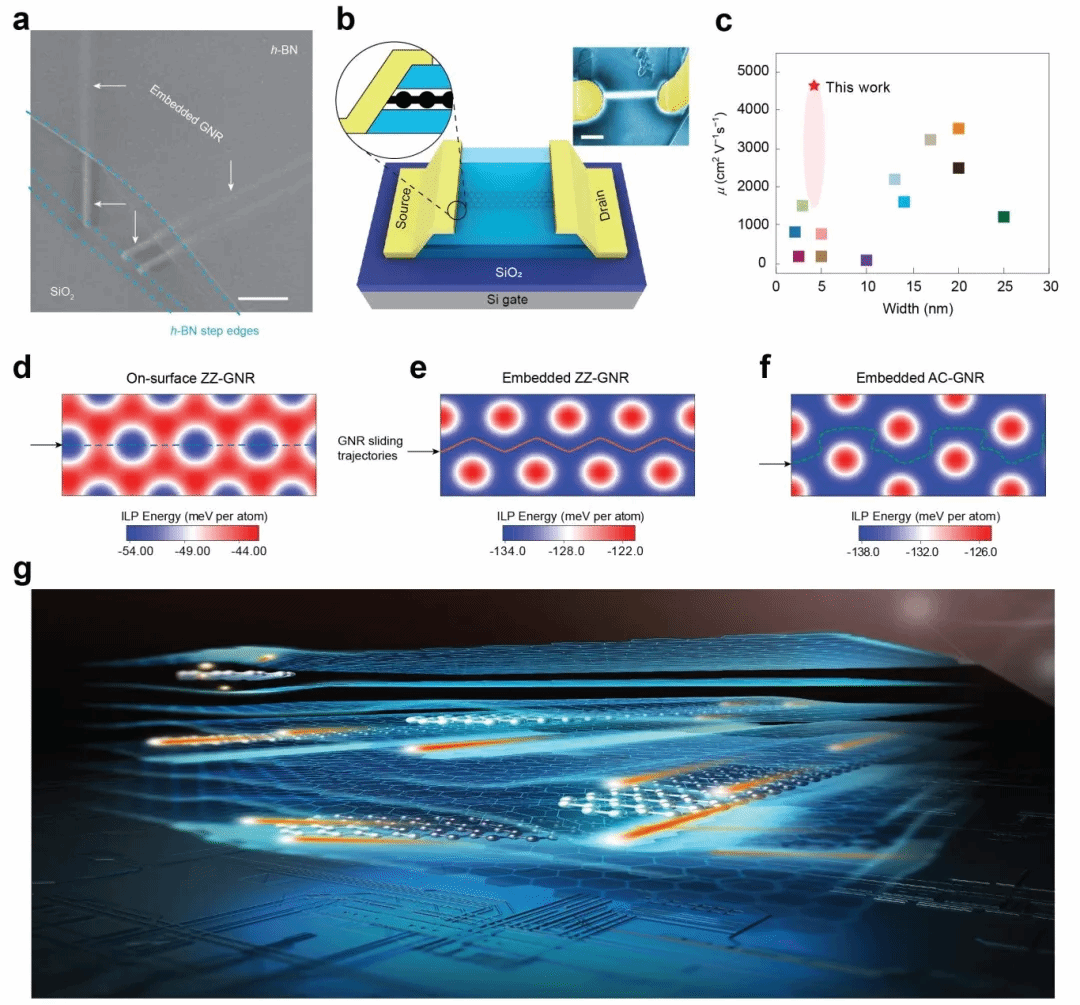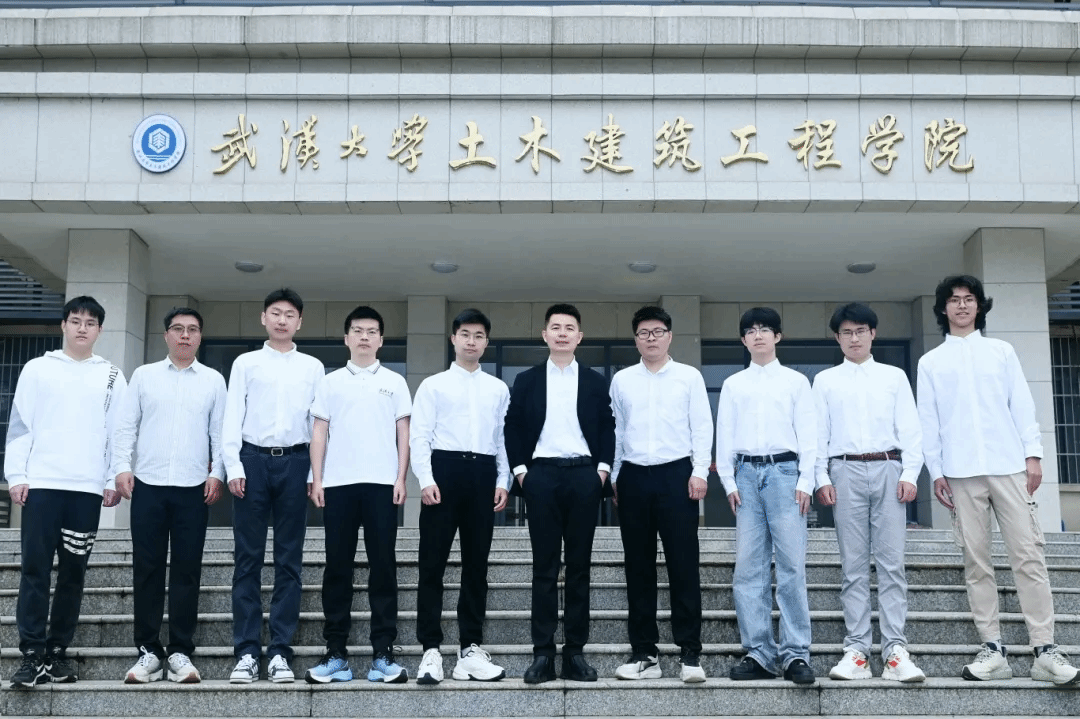Nature publishes findings from Wuhan University and Shanghai Jiao Tong University research collaboration findings
On March 27, Nature published the latest research findings on the growth mechanism of ultra-long graphene nanoribbons in the interlayer of hexagonal boron nitride (hBN) from Prof. Ouyang Wengen’s team at Wuhan University’s School of Civil Engineering and State Key Laboratory of Water Resources Engineering and Management. The paper, published with their collaborators from Shanghai Jiao Tong University, is titled "Graphene Nanoribbons Grown in hBN Stacks for High-Performance Electronics". In this study, the embedded growth of ultra-long, ultra-narrow, single-chiral graphene nanoribbons in hBN crystals was successfully realized and its microscopic mechanism revealed. It was further demonstrated that the grown graphene nanoribbons can be used for the construction of high-performance field-effect transistor devices. This study is a key step toward the atomic fabrication of advanced packaging architectures in microelectronics and is expected to have a significant impact on the field of carbon-based nanoelectronics. Wuhan University is the tied first author affiliation and corresponding author affiliation.

Quasi-one-dimensional graphene nanoribbons (GNRs) have a bandgap that opens due to quantum confinement effect, and the bandgap can be regulated by the GNR width and edge structure, which is expected to make up for the deficiency that the lack of bandgap in intrinsic two-dimensional graphene causes difficulties in using it to fabricate transistor devices directly. It is also an ideal candidate material for future high-performance electronic devices and chips. However, the existing experimental methods are susceptible to disorder effects such as crystal lattice defects, strain, surface roughness, and electric charge impurities in the substrate in the process of preparing GNRs, and it is not yet possible to prepare high-quality GNRs that can be used in semiconductor devices, which makes it difficult to meet the needs of the future development of advanced microelectronics industry.
To address this issue, Prof. Shi Zhiwen's team from Shanghai Jiao Tong University has developed a new preparation method to realize the ultra-long (sub-millimeter scale), ultra-narrow (less than 5 nanometers), and single-chiral growth (zigzag) of GNRs between layers of hexagonal boron nitride. In addition, since this GNR is ‘in-situ encapsulated’ by the hexagonal boron nitride while growing, its structure and properties can be protected from external environmental factors and micro-nano-processing, and the field effect transistors prepared based on this interlayer GNR show excellent performance: carrier mobility up to 4,600 cm2V -1s-1, and a switching ratio of 106, the highest ever achieved in an ultra-narrow GNR. These outstanding performances indicate that the prepared interlayer GNRs are expected to play an important role in future high-performance carbon-based nanoelectronic devices.
In order to reveal the growth mechanism of GNRs between hexagonal boron nitride layers, Prof. Ouyang Wengen's team at Wuhan University conducts large-scale molecular dynamics simulations of the experimental system based on an anisotropic force field developed independently in the previous period, and finds that GNRs exhibit super-slip properties (near-zero frictional wear) when they slip between the hexagonal boron nitride layers and that, relative to other chiral GNRs, the friction of zigzag GNRs slipping between hexagonal boron nitride layers is much lower, which ultimately leads to the growth of ultra-long GNRs single-chirally. The simulation results are supported by the theoretical analysis by Prof. Michael Urbakh’s team at Tel Aviv University and the first principle calculations by Prof. Ding Feng’s team at the Shenzhen Institute of Advanced Technology (SIAT). The computational and analytical methods adopted in this paper are also applicable to general van der Waals layered material systems.

▲Growth, property characterization, and mechanistic analysis of graphene nanostrips between hexagonal boron nitride layers
Dr. Bosai Lv and Dr. Jiajun Chen from the School of Physics and Astronomy at Shanghai Jiao Tong University (SJTU), Dr. Sen Wang from Wuhan University (WHU), Dr. Shuo Lou, Peiyao Shen, and Jingxu Xie from the School of Physics and Astronomy at SJTU, and Dr. Lu Qiu and Dr. Izaac Mitchell from the National Institute of Science and Technology Ulsan (NISTU) in South Korea are the co-first authors of the paper. Prof. Ouyang Wengen of Wuhan University, Prof. Michael Urbakh of Tel Aviv University, Prof. Ding Feng of the Shenzhen Institute of Advanced Technology (SIAT), and Prof. Shi Zhiwen of Shanghai Jiao Tong University (SJTU) are the co-corresponding authors. The paper was also co-authored by Prof. Shiyong Wang, Prof. Ting Xin Li, Prof. Guorui Chen, Prof. Xiaoqun Wang, Prof. Jinfeng Jia, Prof. Qi Liang, Dr. Can Li, Dr. Cheng Hu, and Xianliang Zhou of the School of Physics and Astronomy at SJTU, as well as by Prof. Oded Hod of Tel Aviv University, Israel, and Prof. Kenji Watanabe and Prof. Takashi Taniguchi of the National Institute for Materials Research (NIMR), Japan. This work was supported by the Ministry of Science and Technology, the National Natural Science Foundation of China, the Hubei Provincial Natural Science Foundation of China, and the Talent Initiation Fund of Wuhan University. The computational simulations involved were mainly carried out at the Supercomputing Center of Wuhan University and the National Tianhe II Supercomputing Center, for which we would like to express our deep appreciation.

▲Ouyang Wengen's research team, the sixth from the left is Ouyang Wengen and the seventh from the left is Wang Sen.
Prof. Ouyang graduated from the Department of Engineering Mechanics in the School of Civil Engineering and Architecture at Wuhan University, and received his Ph.D. from the Department of Engineering Mechanics in the School of Aerospace Engineering at Tsinghua University. He studied under Academician Zheng Quanshui, and then completed his postdoctoral research at Tel Aviv University, Israel. He returned to his alma mater as a faculty member in January 2021, and his research interests are in the area of surfaces interfacial mechanics and micro- and nanometer tribology, with a focus on the establishment of multiscale mechanical models, the development of highly efficient computational methods, and building in-situ experimental fine measurement platforms to study and reveal the microscopic mechanisms of non-equilibrium physico-mechanical processes at microscale interfaces. Since joining Wuhan University, he has published more than 20 papers as first/corresponding author in Nature, Physical Review Letters, Advanced Materials, ACS Nano, Nano Letters, National Science Review and other publications. The computational method he developed has been incorporated into the widely used open source molecular dynamics software LAMMPS (https://docs.lammps.org/pair_ilp _graphene_hbn.html) , which has been highly praised by the developers, and is now widely used to study the mechanical, thermal, electrical, and tribological properties of van der Waals interfaces.
Link to paper:
https://www.nature.com/articles/s41586-024-07243-0
Rewritten by Wang Lu
Edited By Yi Kecheng